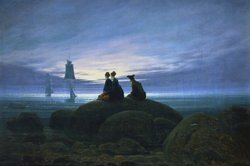Image analysis in art using the example of Romanticism
Erwin Panofski's step model, which is well-known in art, is suitable for image analysis. With his analysis, one can interpret an example from Romanticism in just a few steps. The well-known picture by Caspar David Friedrich "The Wanderer above the Sea of Fog" is used for this.

Image analysis according to Erwin Panofski
- An image analysis in the field of art can take different forms. The analysis according to Erwin Panofski, which is divided into three stages, is known among art historians. It can also be used to interpret a romantic example of a picture.
- Erwin Panofski's analysis begins with the pre-iconographic description. Here the shapes are described in the picture. The forms already have a meaning. If, for example, a sun is shown in a picture, it can also be titled as a sun. However, their shape and color must also be mentioned.
- The pre-iconographic description is followed by the iconographic analysis. It deals with the secondary meaning of forms. Questions are asked such as "Is there an allegory or anecdote told in the picture that was typical of the time the picture was painted?" or "What topics, concepts or gestures are shown in the picture? "," Are people known for the time being shown? "For this part, the analyst needs specific art-historical knowledge, what by literature can be purchased.
- The third step in image analysis is iconological interpretation. For this step above all historical knowledge is necessary in order to put the picture in a historical context. In doing so, the religious and philosophical attitudes of the society that emerged at the time of the work should be placed in a context with the image. Among other things, the question of "What was the worldview prevailing at the time?"
The art of romanticism using the example of "The Wanderer Above the Sea of Fog"
- This image analysis can be applied to the art of Romanticism. "The Wanderer above the Sea of Fog" by the greatest representative of this era, Caspar David Friedrich, serves as an example. The oil painting was created in 1818 and has a size of 74.8 cm x 98.4 cm.
- Pre-iconographic description: The picture shows an elderly gentleman from behind on a stony rock. He is elegantly dressed and holds a walking stick in his right hand. The man looks at a stony landscape in front of him, on which there is fog. Rocks and peaks protrude from the fog.
- The man on the rock offers a color contrast to the fog-rock landscape. The foreground of the picture in which the Lord can be seen is kept very dark. In contrast, there is the foggy landscape, which is kept in light tones and bluish.
- Regarding the geometric division of the picture, it can be said that the man is the center, because all the lines run towards him. In addition, it is located exactly in the central axis of the work. Its central position is also emphasized by the rock on which it stands. This runs to a point and at the top stands the man.
- In the iconographic analysis, it should be said that the image deals with some themes of Romanticism. Above all, it is the subjects of "longing" and "wanderlust" that were very often dealt with in Romanticism. In addition, in literature, painting and other arts, the motif of hiking and travel can be found very often, which is also reflected in this work.
- With regard to the iconological interpretation, it must be said that the Romantic era was strongly influenced by the consequences of industrialization. The world of machines and urbanization arouses people's need for security and connection with nature. In art, literature and music, people flee into fantasy worlds and address dreams in order to escape the Biedermeier, enlightened, rational society.
- The image "The Wanderer Above the Sea of Fog" can be clearly interpreted as romanticism in the image analysis. The man embodies the longing for nature experience, for the distance and a world that is in the fog. At the same time, he embodies the city dweller who falls into melancholy and turns his back on the city. At the same time, the person is a projection figure for the viewer, because he can feel himself into the person through the back view.
Caspar David Friedrich: The morning - analysis
Caspar David Friedrich is an important representative of German Romanticism. How many …
How helpful do you find this article?


